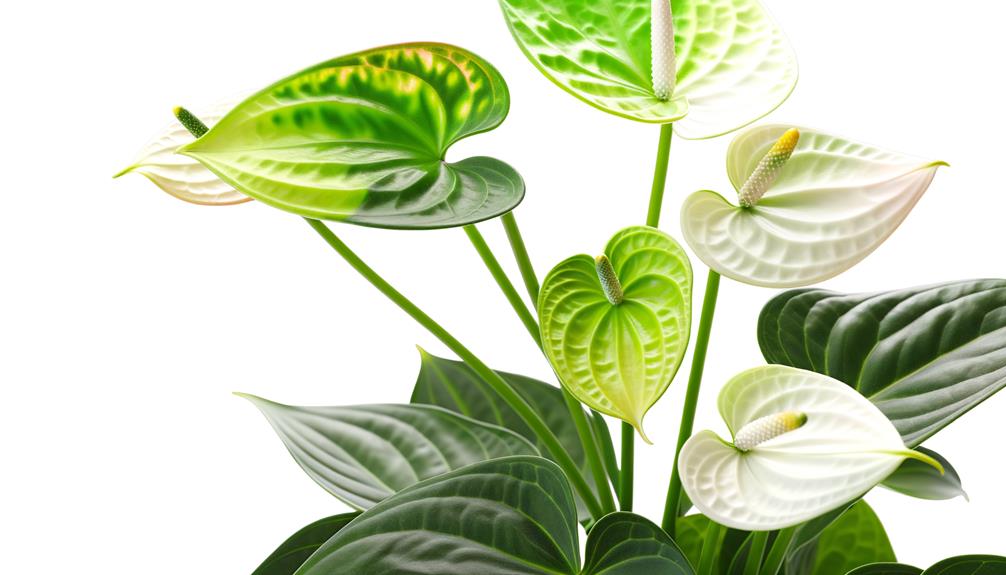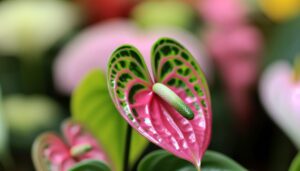Why Are My Anthurium White Flowers Turning Green?
Anthurium white flowers turning green can be attributed to several factors. Inadequate or excessive light exposure can cause changes in chlorophyll production.
Natural aging processes lead to pigment degradation, shifting towards a green hue. Nutrient imbalances, particularly excess nitrogen, also induce overproduction of chlorophyll.
Improper watering, either excess or insufficient, alters root health and pigmentation. Temperature fluctuations, particularly heat stress, can enhance synthesis of chlorophyll, turning the flowers green.
For a thorough understanding of these factors and how to manage them effectively, continue exploring the underlying mechanisms.

Key Takeaways
- Insufficient light exposure leads to chlorophyll degradation, causing white flowers to turn green.
- Excessive nitrogen in the soil can result in overproduction of chlorophyll, altering flower color to green.
- Natural aging of blooms involves pigment shifts, where increased chlorophyll synthesis turns flowers green.
- Heat stress from high temperatures accelerates chlorophyll production, changing flower color from white to green.
- Imbalanced watering practices, particularly overwatering, can lead to root stress and subsequent green pigmentation in flowers.
Light Exposure
Inadequate or excessive light exposure is a primary factor influencing the discoloration of Anthurium white flowers, often causing them to turn green. Photosynthetic processes in Anthurium spp. are highly sensitive to light intensity and quality. Insufficient light can lead to subpar chlorophyll degradation, resulting in a green hue.
Conversely, excessive light, particularly direct sunlight, can induce photoinhibition, stressing the plant and promoting chlorophyll production in the spathes. Best light conditions involve bright, indirect light to maintain the desired white coloration.
Understanding the plant's light requirements is essential; exposure to light within the Photosynthetically Active Radiation (PAR) range of 400-700 nm is ideal for maintaining the anthocyanin pigments responsible for the white coloration, preventing unwanted green pigmentation.
Aging Blooms
The evolution of Anthurium flowers from white to green is a natural part of the aging process, signaling the end of their bloom cycle. This color change occurs due to the degradation of pigments and a shift in cellular composition within the spathe.
Understanding these physiological alterations is vital for proper plant care and anticipating the bloom's lifecycle.
Natural Color Transition
As Anthurium flowers mature, a natural color change occurs, often resulting in their initially white blooms turning green. This transformation is driven by physiological processes within the plant, where chlorophyll begins to dominate as the flower matures. Such a change can be attributed to shifts in pigment composition and cellular metabolism.
| Age of Bloom | Predominant Pigment | Visible Color |
|---|---|---|
| Young | Anthocyanins | White |
| Mid-Age | Carotenoids | Subtle Green |
| Mature | Chlorophyll | Green |
Understanding this phenomenon involves recognizing that the production and degradation of pigments like anthocyanins and carotenoids are integral to the plant's lifecycle. This gradual shift not only signifies aging but also enhances the plant's overall photosynthetic efficiency. Consequently, the green hue in maturing Anthurium blooms is a reflection of their evolving physiological state.
End of Bloom Cycle
Changes in pigment composition not only indicate the maturation of Anthurium flowers but also signal the beginning of the end of their bloom cycle, characterized by additional physiological adjustments as the flower ages.
Chlorophyll synthesis increases, leading to the initial white spathes turning green. This pigment shift is a natural senescence process, where the flower reallocates resources for future growth and survival.
Furthermore, the breakdown of anthocyanins and other pigments also contributes to the color transformation. This senescence stage is distinguished by decreased metabolic activity and cellular respiration within the floral tissues.
Understanding these physiological changes can assist in distinguishing between regular aging and possible indications of stress or disease in Anthurium plants, ensuring suitable care and upkeep.
Nutrient Levels
Inadequate or imbalanced nutrient levels can greatly influence the coloration of Anthurium flowers, potentially causing white blooms to turn green. Essential nutrients, particularly nitrogen, phosphorus, and potassium, play significant roles in pigment production and overall plant health.
Excessive nitrogen can lead to chlorophyll overproduction, resulting in green-tinted flowers. Conversely, phosphorus deficiency may impair pigment synthesis, altering flower color.
To ensure optimal nutrient levels:
- Fertilizer Composition: Use a balanced fertilizer specifically designed for flowering plants.
- Frequency of Application: Follow recommended application rates to avoid nutrient overload.
- Soil Testing: Conduct periodic soil tests to monitor and adjust nutrient levels accordingly.
- Micro-nutrient Availability: Ensure the presence of trace elements like magnesium and iron, critical for pigmentation.
Understanding and managing nutrient levels is crucial for maintaining the vibrant coloration of Anthurium flowers.
Watering Practices
Proper watering methods are crucial for maintaining the health and color of Anthurium flowers. Both excessive watering and insufficient watering can result in stress-induced pigment changes. Excessive watering creates a waterlogged root environment, encouraging root decay and decreasing the plant's ability to absorb necessary nutrients. This can lead to chlorosis and altered pigmentation.
On the other hand, insufficient watering leads to desiccation, causing closure of stomata and subsequent decrease in photosynthetic efficiency. This can potentially result in pigment alteration. Optimal irrigation involves finding a balance; soil should be damp but well-draining. Using a substrate with high organic material and ensuring adequate drainage can alleviate water-related stress.
Regularly monitoring soil moisture levels with a hygrometer can improve accuracy in watering methods. This ensures Anthurium plants remain lively and robust.
Temperature Fluctuations
Temperature fluctuations can impact the pigmentation of Anthurium white flowers. Deviations from the ideal range of 70-85°F can induce physiological stress responses that lead to color changes. These stress responses may alter the biochemical pathways responsible for pigment synthesis, impacting anthocyanin and chlorophyll levels. Subsequently, this can cause the flowers to turn green.
Heat stress can accelerate chlorophyll production, overshadowing the anthocyanins. On the other hand, cold stress from lower temperatures may inhibit anthocyanin synthesis, leading to a dominance of green pigments. Diurnal temperature variation with significant day-night temperature differences can disrupt cellular processes. Additionally, thermal shock from sudden temperature changes can damage plant tissues, triggering defense mechanisms that affect pigmentation.
Understanding these factors is essential for maintaining the aesthetic quality of Anthurium blooms.
Plant Health
Ensuring top plant health is essential for preventing Anthurium white flowers from turning green, as various biotic and abiotic stressors can greatly influence pigment stability and synthesis.
Best nutrient management, especially maintaining sufficient levels of phosphorus and potassium, is necessary for sustaining flower coloration.
Additionally, regular monitoring for pests such as aphids and spider mites is required, as these can induce stress responses leading to chlorophyll proliferation.
Proper irrigation practices to avoid waterlogging and root rot, coupled with maintaining appropriate humidity levels (60-80%), also play significant roles.
Moreover, adequate light intensity and duration are crucial; light deficiency can stimulate green pigment production.
Implementing an integrated pest management and balanced fertilization regime can effectively mitigate these issues, preserving the pristine white flowers.
Conclusion
The transformation of anthurium flowers from white to green is not merely a superficial change. It demands a keen analysis of several underlying factors, including light exposure, bloom aging, nutrient levels, watering practices, temperature fluctuations, and overall plant health.
Each variable holds a pivotal role in this botanical phenomenon. Revealing these interconnected elements may expose the core reason behind this intriguing metamorphosis, leading to more informed horticultural practices and healthier anthurium specimens.






